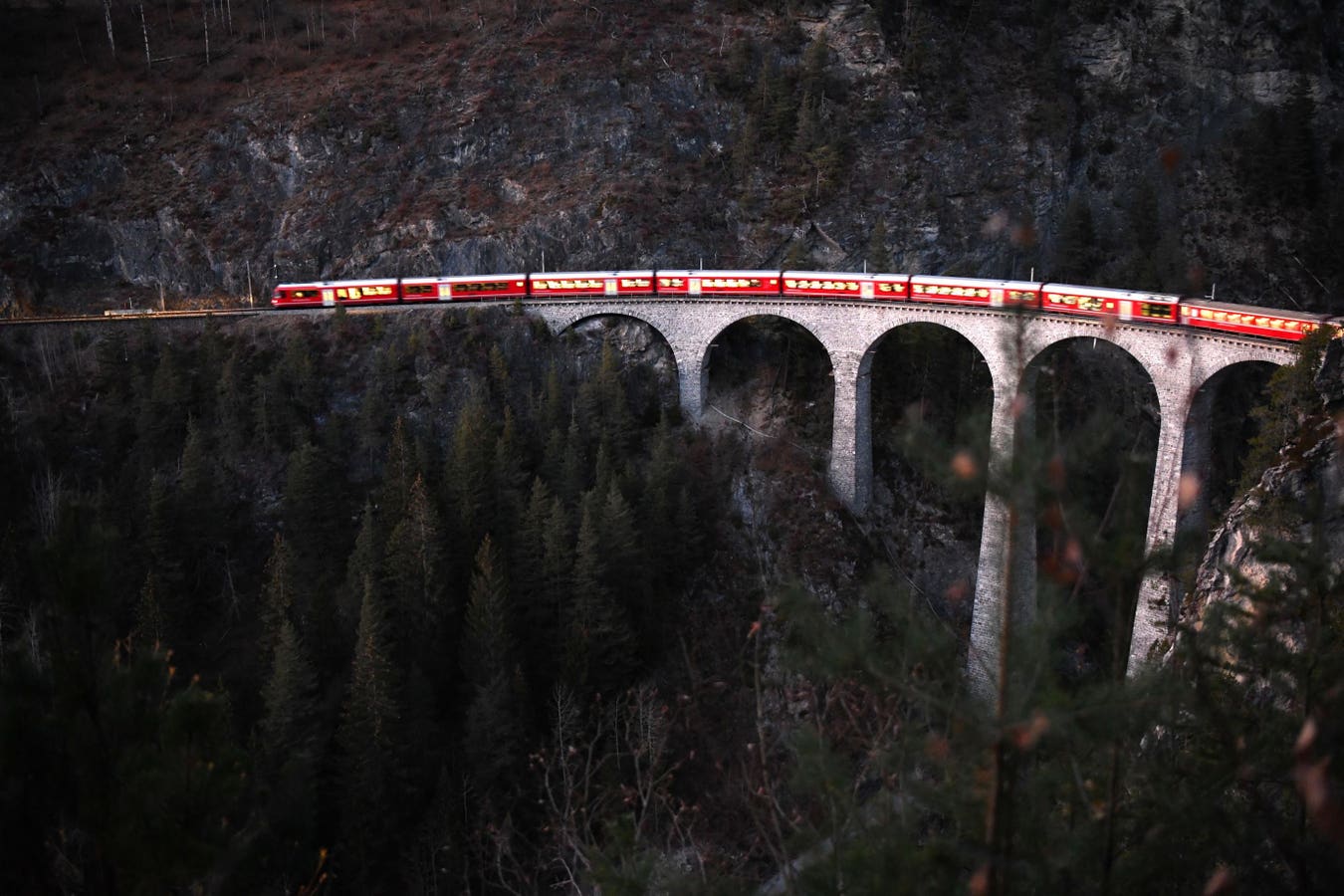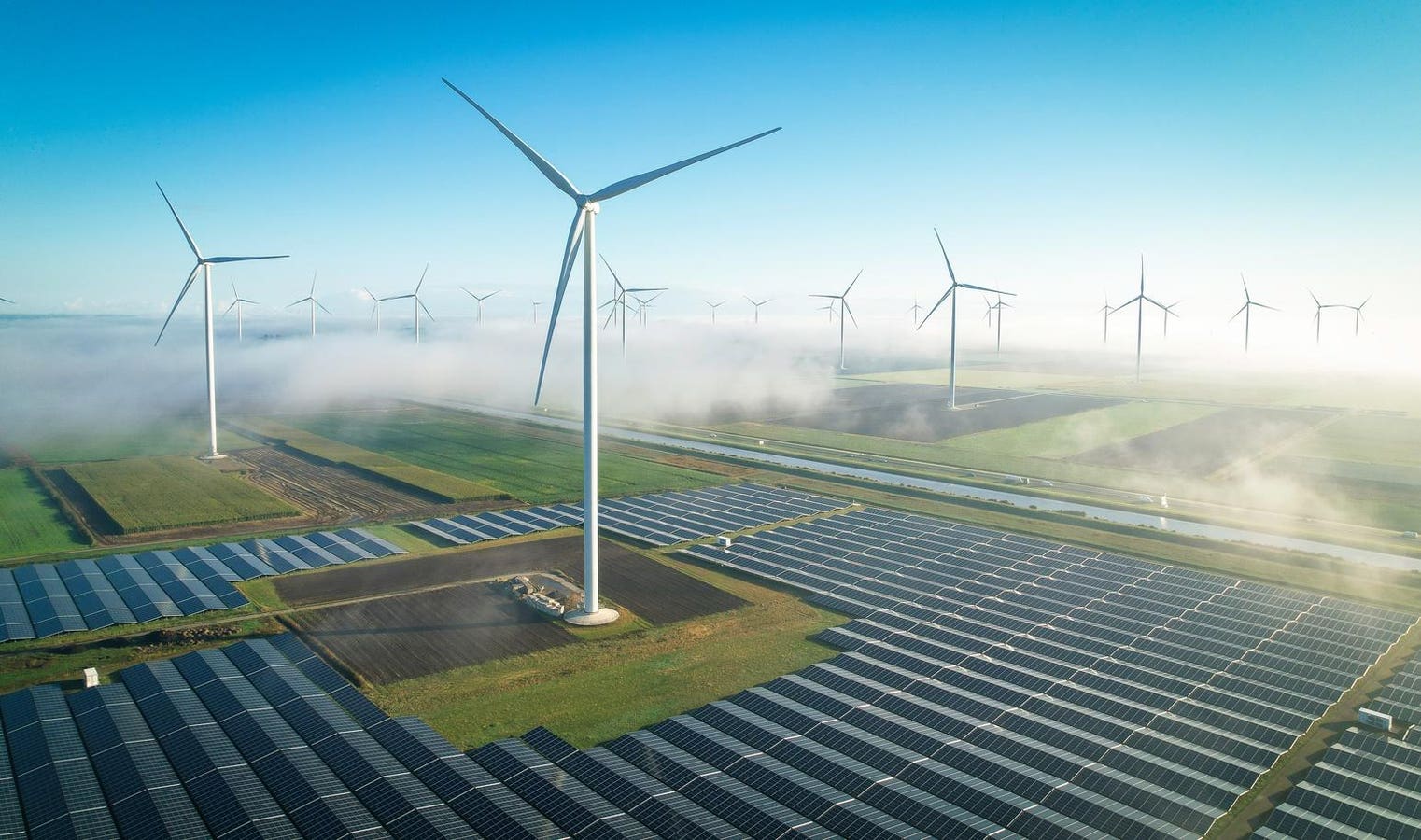A train runs on the Landwasser Viaduct along the Albula-Bernina railway in Switzerland, Dec. 1, 2024. Train travel may be more expensive at times than travelling by air, but it can be prettier. (Photo by Lian Yi/Xinhua via Getty Images)
Xinhua News Agency via Getty Images
European trains are having a renaissance, with a rise in funding, political backing, and increase in passengers, as well as renewed interest in night trains. But one thing still makes rail a tougher choice for travellers: the price — especially versus budget airlines.
Greenpeace analysis of short-haul flights compared to rail journeys found that only 39% of 109 cross-border routes it studied were cheaper than train, with the biggest cross-country gaps seen in France, Spain and the UK, with 90% or more routes cheaper to fly than travel by rail.
Domestic services tended to be better, with 70% of in-country routes cheaper by train.
“Every route where a plane is cheaper than a train is a political failure,” said Herwig Schuster, transport campaigner, Greenpeace Central and Eastern Europe. “We can’t keep rewarding the most polluting form of transport. Europe must make trains the cheapest and easiest option — not the last resort.”
There are answers, the activist group said: simpler tickets, fairer transport taxation, rail infrastructure investment – and more night trains. And that, Greenpeace argues, will benefit the environment as well as consumers.
How bad is the gap between rail and air fares?
The largest price gap spotted by the research was between Barcelona and London, with a flight available for €14.99 for the plane versus €389 on a train on the same day. The journey wasn’t last minute, but planned for a month ahead.
Protesters stand in front of Barcelona Sants railway station with a banner and placards expressing their opinion during the demonstration. The Friday For Future movement in Barcelona has called a demonstration in front of Barcelona Sants, the main railway station in the city, for the United Nations Conference on Climate Change of 2021, COP26, in which they affirm the majority of proposals for the recovery of mobility after Covid-19 are based on false solutions, such as electric and hydrogen cars. (Photo by Thiago Prudencio/SOPA Images/LightRocket via Getty Images)
SOPA Images/LightRocket via Getty Images
A quick search on travel search site Rome2Rio suggests that route on rail would take 12 hours and cost £212 if booked today for a month out, versus £107 for a direct, 2 hour, 15 minute flight — so it’s fair to say there’s more than one reason a flight may appeal more than the train for this specific trip.
A comparison by Ecopassenger of that rail journey with a similar flight — including car travel to get to the airport — shows how significant the environmental difference can be: the rail journey emits 25.1kg of carbon dioxide versus 110.7kg for the flight.
The second biggest gap spotted by Greenpeace was the London to Bratislava route (€21.23 flight versus €494.99 train), with a five-and-a-half hour flight compared to a 16-hour train trip, though there is a night train option too. The third worst was Paris to Copenhagen (€14.99 flight versus €326 train), a five-hour flight versus a 14-hour train trip. None of the ten worst examples offered a direct train route.
On the flip side, the routes with the cheapest trains versus the most expensive flights tended to feature direct routes in Eastern or Central Europe, with Vilnius-Warsaw (€336.94 flight versus €25 train), Košice–Prague (€238.53 flight versus €20.90 train) and Ljubljana-Vienna (€295.77 versus €29.90 train) topping the chart.
Why are flights so much cheaper than rail travel?
Greenpeace points to a few culprits for the cost gap. To start, most rail tickets often attract VAT and face rising energy costs, beyond the already high costs for track access.
But budget airlines — Greenpeace pointed to Ryanair, Wizz Air, Vueling and EasyJet — can offer lower fares in part because international flight fares are normally tax exempt, as is aviation fuel.
A passenger walks past ticket machines at King’s Cross railway station in London. (Photo by Dinendra Haria/SOPA Images/LightRocket via Getty Images)
SOPA Images/LightRocket via Getty Images
Ticket complexity is another concern, with 40% of rail routes analysed requiring the purchase of multiple tickets, rather than what is known as a through ticket. “Rail travel tends to become more expensive when multiple operators and separate tickets are involved, with fares varying between companies,” the report noted. “While rail fares generally increase with distance, flight fares do not follow the same pattern – making air travel often cheaper than rail on longer routes.”
That combination of factors means that flying continues to be the cheapest option much of the time. “Even as the climate crisis worsens, Europe’s tax system continues to favor the most polluting way to travel,” Schuster in a statement. “Aviation enjoys unfair tax privileges, while train passengers are left to pay the price. These prices don’t reflect a functioning market — they reflect a rigged system.”
While flights may be financially cheaper, they are of course environmentally costly: Greenpeace said flights emit five times the emissions per passenger than trains on average, but for rail services using renewable energy, that changes to 80 times more.
Plus, these financial costs and emissions are for the ticket and associated travel alone: as most airports are out of town, transport costs and energy use getting to the airport worsens the picture.
What can be done to make train tickets cheaper?
To help address the price gap, Greenpeace is calling for reforms to transport policy that would end subsidies for aviation, simplify rail tickets, and invest in rail infrastructure, as well as introduce more affordable “climate tickets” that offer flat-rate or discounted travel, such as those trialled by Spain and Germany.
Beyond that, European nations could set up funds to help make rail travel cheaper, subsidising it with a “fair taxation scheme” on aviation, starting with business-class and first-class flights, the activist group said in its report.
The rise of night trains
Europe’s expanding night train network could make a huge impact, Greenpeace said.
“Night trains are the best option for climate-friendly journeys over longer distances,” the report said.
Passengers are pictured in fornt of a Nighjet train from Vienna (Austria) to Roma (Italy) of the Austrian Federal Railways (OeBB) at the Vienna Main Railway Station on February 27, 2019. – Finding the light in the compartment, stowing your suitcase under the bench, installing the sheet: every evening, the ritual is repeated in Vienna station, a rare European city to offer a wide range of cross-border night trains at a time of low-cost flights. (Photo by ALEX HALADA / AFP) (Photo credit should read ALEX HALADA/AFP via Getty Images)
AFP via Getty Images
Out of the total 142 routes examined, 29 were routes that would make for unreasonably long journeys if they didn’t include a night train.
Those routes included Stockholm to Berlin, London to Vienna, and Prague to Amsterdam.
Beyond potentially saving a night in a hotel, night trains tend to be cheaper than day trains, especially in France and Italy, the report noted, in part because they have fewer transfers and fewer different operators.
Indeed, in Italy, the only cross-border route where the train was cheaper than a flight more days than not was the Rome to Vienna route, where Austrian railway OBB operated a direct night train. In Romania and Moldova, a direct night train between Bucharest and Chișinău was always cheaper than the flight — despite Wizz Air offering a fare for €31.
There’s a big caveat here: this price comparison looked at the cheapest night train option, which can involve sleeping in a seat or a shared couchette. Booking a night train with a private compartment or bed will be more expensive.
Greenpeace called for more night trains, in particular on routes that lack an otherwise reasonable rail connection, including Madrid to Rome, Lisbon to Barcelona, and Tallinn to Berlin. Plus, it suggested countries reduce or waive track access charges for trains — but night trains in particular.
Rail fares versus air travel by country
The research was broken down by country, and while it’s a relatively small sample size, there were clear differences, in particular with cross-border routes.
Greenpeace said 54% of the time flying was cheaper on those routes at least six out of nine days, with trains likely to be cheaper for cross-border routes in Central and Eastern Europe, and flights cheaper for cross-border routes 95% the time in France, Spain and the UK.
The report looked at 14 routes in the UK, of which ten were cross border — and nine of those routes were more expensive to take the train than fly nearly all of the time. That’s perhaps not a surprise given the high availability of budget airlines in the UK, as well as the high costs associated with rail travel via the Channel Tunnel.
Greenpeace’s report noted that the Eurostar services kept the UK well connected with the continent, but added: “Of all train routes analysed, Eurostar recorded the highest fares.”
A Eurostar passenger train arrives to enter the Channel Tunnel, operated by the company Eurotunnel, in Coquelles, northern France, on April 4, 2025. (Photo by Sameer Al-DOUMY / AFP) (Photo by SAMEER AL-DOUMY/AFP via Getty Images)
AFP via Getty Images
That could be set for some competition with the rise of new operators to rival the Eurostar, good news for travellers hoping to access Europe’s wider rail network, in particular night trains from Paris or Brussels.
Domestically, two of the four routes saw cheaper rail tickets than airfares. While the Glasgow to London route is cheaper via rail, the Edinburgh to London route is almost always more expensive by rail — a shame as it’s one of the busiest short-haul fight routes in Europe, Greenpeace noted.
France and Italy also trended poorly with cross-border routes, with trains more expensive on most routes on most days.
It was a different story in the Baltics, where all five cross-border routes were cheaper via train most days, or in Poland, where seven out of nine cross border rights were cheaper on eight or nine days of the total nine studied.
In Germany, Austria and Switzerland, about trains were cheaper about half of the time on cross-border routes, though that largely depended on the destination, the report noted.
Improvement on train travel costs
On the upside, the gap has shrunk a bit since 2023. That’s partly because of rising flight prices, in particular when it comes to using connecting flights to save costs, Greenpeace said, but it also credited the addition of new or better rail connections.
Greenpeace showed that versus 2023, the share of routes where trains were cheaper than flying on six out of nine days rose from 27% to 41%.
“This is partly due to more direct rail connections and fewer ultra-cheap connecting flights via low-cost hubs such as London and Dublin,” the report noted. “However, the trend is too slow, and a full overhaul of the pricing system is needed to effectively tackle the climate crisis and to make rail cheaper than flying on all routes.”
Over 111 routes tracked by Greenpeace in 2023, in just 23 cases (21%) trains were cheaper than flying eight or nine times out of nine days checked. That has risen to 30 routes in 2025, about 27% of routes examined in both years.
Routes with better results now than in 2023 included Vienna to Warsaw, Berlin to Brussels, and Glasgow to London.









